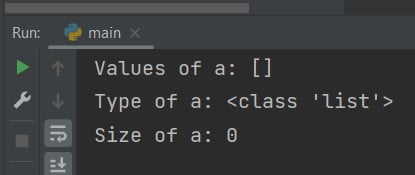Initializing and Populating Lists
In Python, lists are a fundamental data structure used to store collections of data. A list can contain a variety of data types, including strings, integers, floats, and even other lists. When working with lists, it’s essential to initialize them correctly to avoid errors and ensure efficient data manipulation. One of the most common ways to initialize a list is by creating an empty list, which can be done using the `list()` function or by assigning a pair of square brackets `[]` to a variable. For instance, `my_list = list()` or `my_list = []` both create an empty list. This is a crucial step, as it lays the foundation for more advanced list operations, such as adding elements to an empty list in Python. By understanding how to create and populate lists, developers can unlock the full potential of Python’s list data structure.
The Art of Adding Elements to a List
In Python, adding elements to a list is a fundamental operation that allows developers to dynamically modify and extend their data structures. There are several methods for adding elements to a list, each with its own strengths and use cases. The `append()` method, for instance, allows developers to add a single element to the end of a list. On the other hand, the `extend()` method enables the addition of multiple elements to a list, making it a convenient option when working with large datasets. Understanding the differences between these methods is crucial, as it can significantly impact the efficiency and readability of code. For example, when adding elements to an empty list in Python, the `append()` method is often the preferred choice, as it allows for the incremental construction of a list. By mastering the art of adding elements to a list, developers can unlock the full potential of Python’s list data structure and write more efficient, scalable code.
How to Add Elements to an Empty List in Python
Adding elements to an empty list in Python is a fundamental operation that allows developers to dynamically construct and modify their data structures. To add elements to an empty list, developers can use various methods, including the `append()` and `extend()` methods. Here’s a step-by-step guide on how to add elements to an empty list in Python:
**Adding a Single Element**: To add a single element to an empty list, developers can use the `append()` method. For example, `my_list = []; my_list.append(“apple”)` adds the string “apple” to the empty list `my_list`. This method is particularly useful when adding elements one at a time.
**Adding Multiple Elements**: To add multiple elements to an empty list, developers can use the `extend()` method. For example, `my_list = []; my_list.extend([“apple”, “banana”, “orange”])` adds the list `[“apple”, “banana”, “orange”]` to the empty list `my_list`. This method is particularly useful when adding multiple elements at once.
**Adding Elements from Other Data Structures**: Developers can also add elements from other data structures, such as tuples or dictionaries, to an empty list. For example, `my_list = []; my_tuple = (“apple”, “banana”, “orange”); my_list.extend(my_tuple)` adds the elements of the tuple `my_tuple` to the empty list `my_list`.
By mastering the art of adding elements to an empty list in Python, developers can create dynamic and flexible data structures that meet their specific needs. Whether adding single elements, multiple elements, or elements from other data structures, Python’s list operations provide a powerful toolset for data manipulation and analysis.
Common Pitfalls to Avoid When Adding to an Empty List
When adding elements to an empty list in Python, developers often encounter common pitfalls that can lead to errors, inefficiencies, and frustration. By being aware of these pitfalls, developers can avoid common mistakes and write more efficient, effective code.
**Attempting to Add Elements to a Non-Existent List**: One of the most common mistakes developers make is attempting to add elements to a non-existent list. This can occur when a list is not properly initialized or when a variable is not assigned to a list. To avoid this mistake, ensure that the list is properly initialized before adding elements.
**Using the Wrong Method**: Another common mistake is using the wrong method to add elements to an empty list. For example, using the `append()` method to add multiple elements can lead to inefficiencies and errors. To avoid this mistake, understand the differences between the `append()` and `extend()` methods and use the correct method for the task at hand.
**Not Handling Errors**: Failing to handle errors when adding elements to an empty list can lead to unexpected behavior and errors. To avoid this mistake, use try-except blocks to handle errors and exceptions, and ensure that the code is robust and fault-tolerant.
**Not Optimizing List Operations**: Adding elements to an empty list can be an inefficient operation, especially when working with large datasets. To avoid this mistake, optimize list operations by using efficient algorithms and data structures, and minimize the number of operations performed on the list.
By being aware of these common pitfalls, developers can avoid common mistakes and write more efficient, effective code when adding elements to an empty list in Python. By following best practices and avoiding common mistakes, developers can master the art of adding elements to an empty list and unlock the full potential of Python’s list data structure.
Best Practices for List Manipulation in Python
When working with lists in Python, it’s essential to follow best practices to ensure efficient, effective, and error-free code. By adhering to these best practices, developers can optimize list operations, handle errors, and write efficient code.
**Optimize List Operations**: When adding elements to an empty list in Python, it’s crucial to optimize list operations to minimize computational overhead. This can be achieved by using efficient algorithms, such as using the `extend()` method instead of `append()` for adding multiple elements.
**Handle Errors**: Errors can occur when adding elements to an empty list, such as attempting to add elements to a non-existent list or using the wrong method. To handle errors, use try-except blocks to catch and handle exceptions, and ensure that the code is robust and fault-tolerant.
**Write Efficient Code**: Writing efficient code is critical when working with lists in Python. This can be achieved by minimizing the number of operations performed on the list, using efficient data structures, and avoiding unnecessary computations.
**Use List Comprehensions**: List comprehensions are a powerful tool in Python that can be used to create and manipulate lists efficiently. By using list comprehensions, developers can write concise, efficient code that minimizes computational overhead.
**Avoid Mutating Lists**: Mutating lists can lead to unexpected behavior and errors. To avoid this, use immutable data structures, such as tuples, or create a new list instead of modifying an existing one.
By following these best practices, developers can master the art of list manipulation in Python and write efficient, effective code that meets their specific needs. Whether adding elements to an empty list or performing complex list operations, these best practices provide a solid foundation for working with lists in Python.
Real-World Applications of Adding to an Empty List
In various real-world scenarios, adding elements to an empty list in Python is a crucial operation. From data processing to scientific computing, web development, and more, the ability to efficiently add elements to an empty list is essential.
**Data Processing**: In data processing, adding elements to an empty list is necessary for tasks such as data cleaning, data transformation, and data analysis. For instance, when processing a large dataset, adding elements to an empty list can help to filter out irrelevant data, transform data formats, or perform statistical analysis.
**Scientific Computing**: In scientific computing, adding elements to an empty list is used to perform complex calculations, simulations, and data analysis. For example, in numerical analysis, adding elements to an empty list can help to solve linear algebra problems, perform numerical integration, or simulate complex systems.
**Web Development**: In web development, adding elements to an empty list is used to create dynamic web applications, handle user input, and store data. For instance, when building a web application, adding elements to an empty list can help to store user preferences, handle form submissions, or create dynamic content.
**Machine Learning**: In machine learning, adding elements to an empty list is used to preprocess data, train models, and evaluate performance. For example, when building a machine learning model, adding elements to an empty list can help to preprocess data, create feature vectors, or evaluate model performance.
By understanding how to add elements to an empty list in Python, developers can unlock the full potential of these real-world applications and create efficient, effective solutions that meet their specific needs.
Troubleshooting Common Errors When Adding to an Empty List
When adding elements to an empty list in Python, developers may encounter various errors that can hinder their progress. To troubleshoot these errors, it’s essential to understand the common pitfalls and mistakes that can occur.
**Syntax Errors**: One of the most common errors when adding to an empty list is syntax errors. For example, forgetting to close the list brackets or using the wrong syntax for the `append()` or `extend()` methods can lead to syntax errors. To avoid this, ensure that the syntax is correct and the list brackets are properly closed.
**Type Errors**: Type errors can occur when attempting to add elements of the wrong data type to an empty list. For instance, trying to add a string to a list of integers can lead to a type error. To avoid this, ensure that the elements being added are of the correct data type.
**Logic Errors**: Logic errors can occur when the logic of adding elements to an empty list is flawed. For example, attempting to add elements to a non-existent list or using the wrong method can lead to logic errors. To avoid this, ensure that the list exists and the correct method is used.
**Index Errors**: Index errors can occur when attempting to access an element in an empty list. For example, trying to access the first element of an empty list can lead to an index error. To avoid this, ensure that the list is not empty before attempting to access its elements.
**Attribute Errors**: Attribute errors can occur when attempting to use a method or attribute that does not exist for an empty list. For example, trying to use the `sort()` method on an empty list can lead to an attribute error. To avoid this, ensure that the method or attribute exists for the list.
By understanding these common errors and taking steps to avoid them, developers can troubleshoot and resolve issues when adding elements to an empty list in Python, ensuring efficient and effective list operations.
Conclusion: Mastering List Operations in Python
In conclusion, mastering the art of adding elements to an empty list in Python is a crucial skill for any developer. By understanding the different methods for adding elements, avoiding common pitfalls, and troubleshooting errors, developers can efficiently and effectively manipulate lists to achieve their goals.
Whether it’s data processing, scientific computing, or web development, the ability to add to an empty list in Python is an essential tool in any developer’s toolkit. By following the best practices and guidelines outlined in this article, developers can ensure that their list operations are optimized, efficient, and error-free.
Remember, adding to an empty list in Python is not just about appending elements; it’s about understanding the underlying mechanics of lists, avoiding common mistakes, and writing efficient code. By mastering this fundamental concept, developers can unlock the full potential of Python’s list data structure and take their coding skills to the next level.
With practice and patience, developers can become proficient in adding to empty lists in Python, and unlock a world of possibilities in data processing, scientific computing, and web development. So, start practicing today and take the first step towards mastering list operations in Python!





